* (Halloween countdown post #11)

‘Lucio Fulci is best remembered for his delirious hallucinatory and visceral horror films of the late 1970s and early 1980s. Expressed in these films was a creative libation of splanchnic yet nonetheless seductive images strung together by loose, almost incoherent, narratives. As a director, Fulci has worked in most genres. In over 60 films and 120 scripts he has shown himself to be a film pragmatist, working within generic and financial constraints to produce films which intensified during certain periods of time and style to redefine genre and cinematic pleasure.
‘Born in Rome in 1927, Lucio Fulci’s indoctrination into film could be described as theoretical. While this is poignantly reminiscent of those critics who claim his direction as ‘great’ is similarly theoretical and not necessarily borne out in his technique, Fulci’s beginnings as an art critic and medical student created the first levels of a baroque palimpsest, defined by flesh folded in new configurations which simultaneously folds the viewer in a visceral rather than conceptual way. These beginnings received diverse and somewhat oddly configured additional plateaus through training at Luchino Visconti’s Experimental Film School with film philosophers such as Nanni Loy, Umberto Barbaro, Francesco Maselli and Luigi Chiarini rather than technicians or cinematic artisans.
‘Fulci began his public career scriptwriting and making rudimentary documentaries such as Pittori Italiano dei dopoguerra (1948). During this time he worked under Luchino Visconti, Roberto Rossellini, Federico Fellini, Steno and Mario Bava. However the insistence of many critics and filmographers on emphasising this effulgent genesis seems symptomatic of the compulsion to redeem Fulci as a serious or valuable director. Essentially at this time Fulci primarily demonstrated his ability to perform technical tasks which fulfilled other people’s projects. Later, in reference to his most established and praised works one could claim he was similarly fulfilling the demands of producers to make quick, cheap films that would sell. Fulci’s talent seems therefore to lie not necessarily in some auteurist vision, but in his capacity to create beauty, perversion and surprise – perhaps due to, rather than in spite of, his constraints.
‘The project of describing the best of Fulci’s films, his gory horrors, is a paradoxical one. Being required to describe these films might expose them as poverty stricken within the constraints of signification of images, narrative and their capacity to be viewed as a readerly text. In order to evoke the powers of Fulci’s best films I must first reconfigure the seemingly given paradigms of cinema. Here I ask the reader to variously rethink or forgo these concepts as necessary for cinematic pleasure. This involves letting go of: narrative as a temporalisation of viewing pleasure which accumulates the past to contextualise the present and lay out an expected future; images as deferrals to meaning, signs to be read or interpreted; characters as integral to plot, both in film in general and horror in particular as that which must be conceptually characterised in order to be meaningfully killed off or destroyed; narrative as intelligible contextualiser of action; exploitation as gratuitously existing for its own sake or to affirm and intensify traditional axes of oppression in society; gore as demeaning or a lesser focus in the impartation of visual expression; pleasure as pleasurable; repulsion as unpleasurable; violence as inherently aggressive; horror as dealing only with notions of returned repression, infantilism or catharsis. I ask the reader, in the tradition of Lyotard’s economy of libidinal pleasure, to shift their address from why or what the images mean to how they affect.
‘Fulci began his gore film series with the George A. Romero figlia Zombi 2, a surprisingly engaging reconfiguration of the Living Dead mythos, where the ethnographic zombie films of Val Lewton contracted with the bodily horror of George Romero in the USA and Jorge Grau in the UK. Fulci’s success in presenting gore anchors on his acute understanding of violence against bodies as reliant on the particular significations of the parts of the body being destroyed, rather than a semiotic destruction of flesh in general, hence his propensity for showing eyeball puncturing. His zombies are cheap looking, but this makes them unnerving in their abject grittiness, rather than unconvincing. Fulci followed Zombi 2 with his opus latifundium, his “real estate” trilogy: Paura nella città dei morti viventi (City of the Living Dead, 1980), a Lovecraftian story of a priest who hangs himself thus opening the gates of hell; L’aldila, about a hotel which is a gate to hell (noticing a theme?), and Quella villa accanto al cimitero (House by the Cemetery, 1981), about one Dr Freudstein – surely one of the best ever character names in a film! – who, by transplanting parts of his victims to his body for over a century has managed to stay alive, although, in keeping with the trilogic theme, he looks like hell. These films saw the first paradigmatic shift in Fulci’s interest from the temporality that defines traditional cinematic narrative, to a focus on space, broadly meaning atmosphere, acts which may or may not bear relevance to preceding and successive images, claustrophobic mise en scène set within houses and damp landscapes which drip with the viscosity of the bodies crawling therein. Fulci manages this oppressive environment even in the clinical world of the pathology lab or the infinite space of the bridge which leads to the island of New Orleans, both in L’Aldila. These films resonate with places rather than people, events rather than story, ergo ecstasy (event outside of temporality) rather than time. Fulci states “Our only refuge is to remain in the world but outside time”. It may seem a stretch to claim Fulci distorts time in the same way as more deliberately artistic filmmakers; his films retain a rudimentary relationship with narrative, whether for the sake of loose coherence or the producers of the film.
‘These three films saw Fulci collaborate with screenwriter Dardano Sacchetti, who had previously written Il gatto a nove code (with Argento) and Reazione for Bava. Sacchetti later wrote the stories for Lamberto Bava’s first films, La Chiesa (1989) for Michele Soavi, two screenplays for Ruggero Deodato and Sergio Martino (in collaboration with the brilliant Ernesto Gastaldi) and the strange yet fascinating Apocalypse domani (1980) for Antonio Margheriti. For Fulci, Sacchetti wrote the giallo 7 note and his later gore films Manhattan Baby (1982) and the controversial slasher pseudo-giallo film Lo squartatore di New York (The New York Ripper, 1982). The third member of the trilogy responsible for Fulci’s most accomplished work is Giannetto De Rossi, whose special effects are more interested in the body transformed rather than destroyed by violence. It is this alchemical combination that formed the delirious dream-like worlds of the real-estate trilogy. Whether the viewer awaits a narrative to explicate the murders, the reanimation of the dead and the baroque methods of death, or whether they are there to explore the sensations of the images unto themselves, these films offer images as possibility – the possibility of experiencing film otherwise, the possibility of meaning without the satisfaction of affirmation of interpretation, and the possibility of the masochism of watching horror, an eternal anticipation that confuses rather than pleases when the shocking images arrive.
‘In Cinema 2, Gilles Deleuze states: [firstnes
s] is not a sensation, a feeling, an idea, but the quality of a possible sensation, feeling or idea. Firstness is thus a category of the possible: it gives a proper consistency to the possible, it expresses the possible without actualising it…this is exactly what the affection-image is.
‘If firstness is the primary moment, before language orients effect toward the eternal deferral of meaning through signification, then firstness repudiates language as these films repudiate film language. Because films do unfold in time and because these films are not experimental, they do indeed include rudimentary road signs for the viewer, but these are distraction rather than moments of intensification which inhabit the films. The narratives are there but they don’t matter, what matters is the very matter of the images, their materiality. Deleuze calls the image which subjugates movement to time the chronosign: … the before and after are no longer themselves a matter of external empirical succession, but of the intrinsic quality of that which becomes in time. Becoming can in fact be defined as that which transforms an empirical sequence into a series: a burst of series.
‘These films are about intrinsic quality, texture, consistency. For this reason they affect sense rather than intellect – confusion, disgust, suffering, delight at the pangs of horror are the qualities these films evoke. The screen is not the marker between actual and virtual but, in Paul Virilio’s words, the “osmotic membrane”. Nowhere does this osmosis become more apparent than in films which affront the sensoria of the viewer without recourse to the dividing wall of signification and deferral to meaning which protects the viewer from affect. Pierced eyeballs, crucifixion, spiders eating a face, bodies melted with acid, pneumatic drills through the head, but also the aesthetics of white blinded eyeballs, the tension of Dr Freudstein in Quella forcing a child’s head against a door into which his parents are hurling an axe to ‘save’ him from the bloody Doctor, the blind Emily having her throat torn out by her guide dog (in a perverse homage to Argento’s Suspiria) and Fabio Frizzi’s scores for Paura and L’Aldila which give Goblin a run for their money all create impossible worlds which demand a visceral affiliation. I should add, to describe what happens in these films, which may make them sound shocking or provocatively perverse, entirely fails to express the certain qualities of these images that makes any description of them inherently redundant – it is not what happens or why it happens, but how it happens that makes these images seductive. The worlds of Fulci’s real estate trilogy are ridiculous, false, phantasmatic but perhaps it is this very phantasy which protects the films from the mean spiritedness that sometimes threatens to overwhelm those violent gore films which locate themselves entirely within the real world, turning baroque violence into vulgar and potentially misogynistic sadism. …
‘After an early 1980s creative flurry (The New York Ripper, Manhattan Baby, The Black Cat, a.o.) Fulci began his descent into films which express a clear lack of interest in his art. Due to the plethora of films I will focus the following summary on key films which signify various aspects of Fulci’s later work. Un gatto nel cervello (1990, dedicated to Clive Barker, “my only friend”) is a composite of all the gore from Fulci’s previous films, told in a story about a film director called Lucio Fulci, played by Fulci (an extension of his Hitchcockian habit of playing cameos in his films), which both parodies his label as the Italian godfather of gore, and mourns this label’s misunderstanding of a true vision beneath, yet elaborated through, the gore. Fulci’s worst film, not due to ineptitude but a real misogynistic turn, Quando Alice ruppe lo specchio (1988), where female ugliness vindicates gratuitously sadistic murder, is ambiguously something which gives the kind of audience he despises what they think they want, and a bitter reflection on his career. The later phantasy horror films, here more gothic than baroque due to their turn from corporeal viscerality to ethereal atmosphere, are seductive and point to Fulci’s remaining potential. Il fantasma di Sodoma (1988), a story of Nazi ghosts haunting a group of teenagers, and Demonia (1990), where Loudonic nuns drink blood and haunt archaeologists, are interesting interpretations from the standard Italian genres of nunsploitation and Nazi fetishism alongside teens-in-peril. The films are headily impressive, the air almost tactile, the atmosphere acrid and voluminous. These films make flesh of phantasms and offer ghosts which are vague in a visceral rather than ethereal manner. However nothing of the residue of Fulci’s talents in the film can make them any more than they are, which is a series of almost poignant reminders of Fulci becoming somewhat of a simulacrum of what he once was. They are pretty, sometimes delicious, but irredeemably diluted. This prettiness without substance reached its zenith with Fulci’s final film Voci dal profondo (1994). Fulci died destitute from diabetes on March 13, 1996.’ — Senses of Cinema
___
Stills



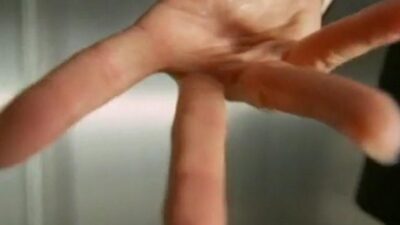
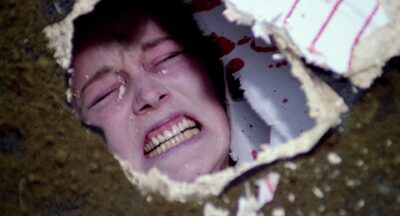



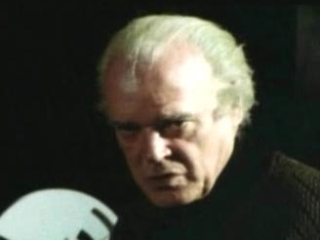


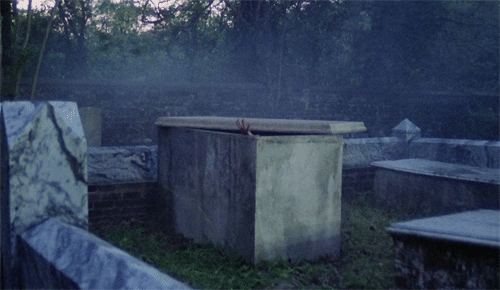

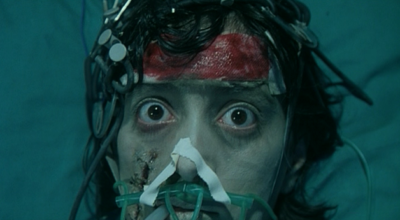


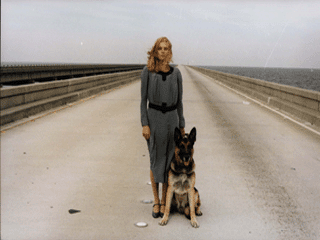
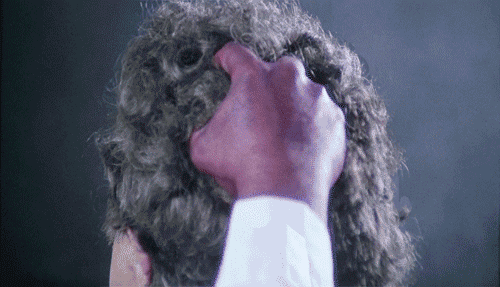
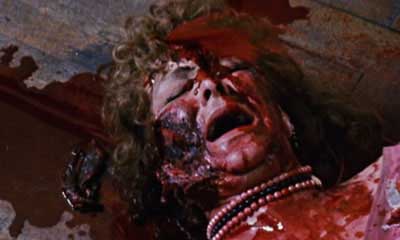


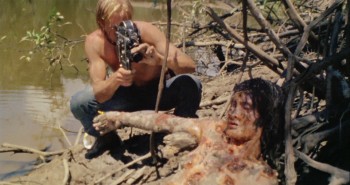
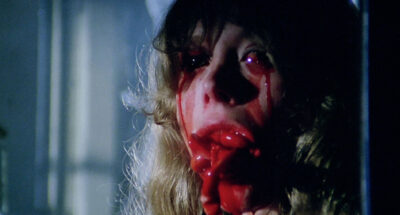
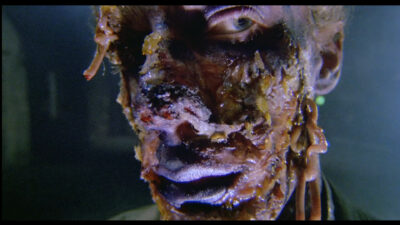


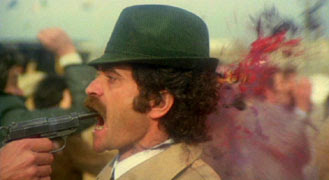




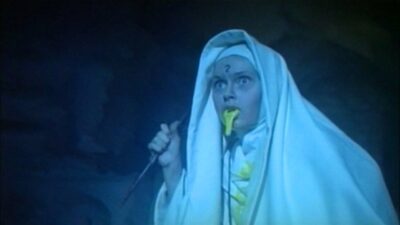



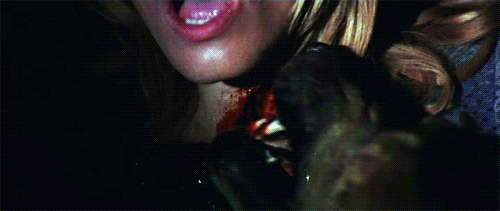

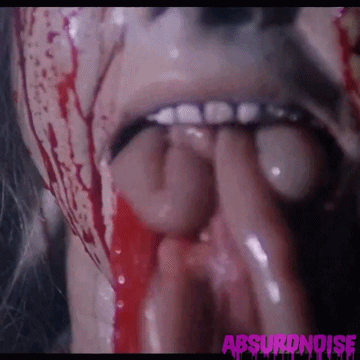
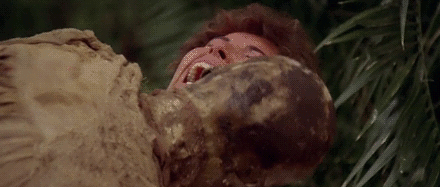


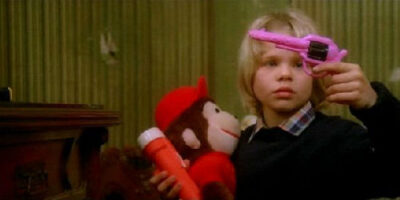



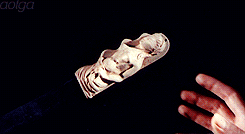

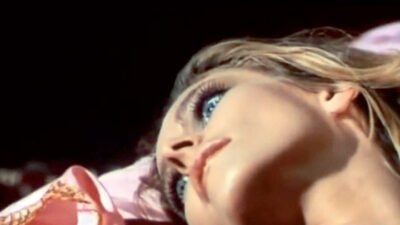










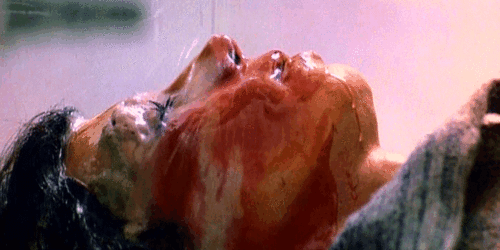







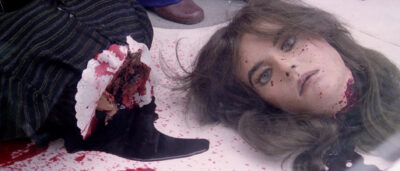
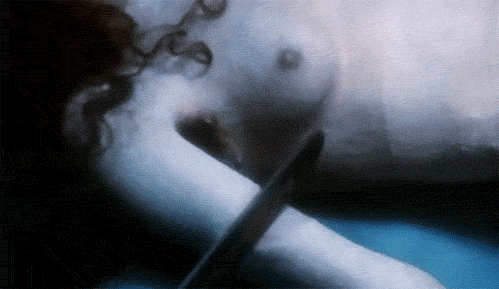
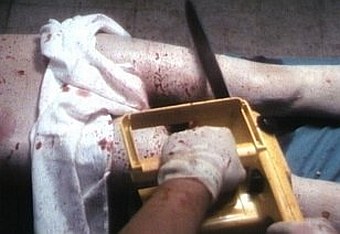

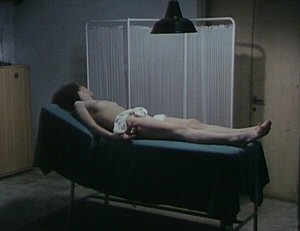
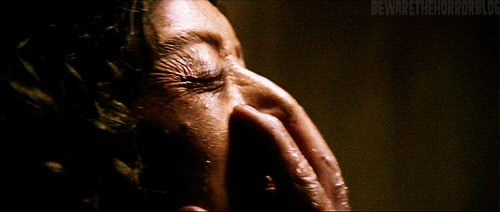
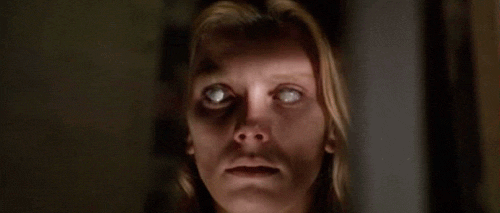
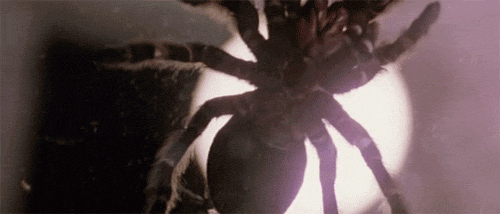


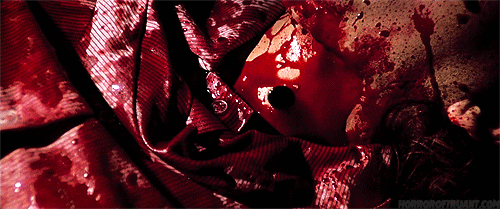
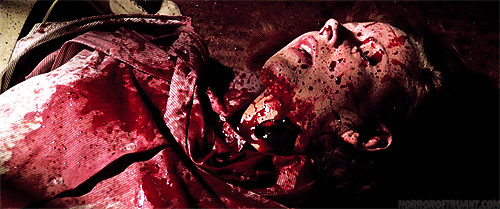
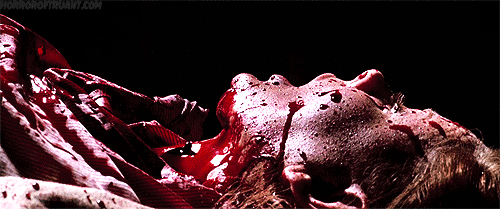
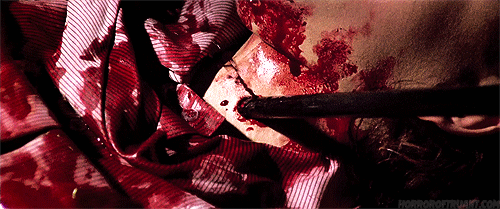






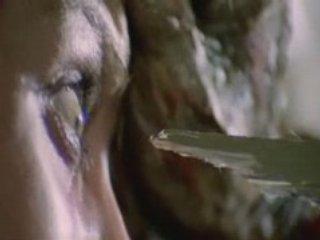

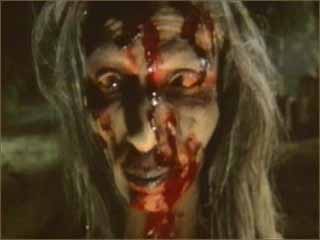

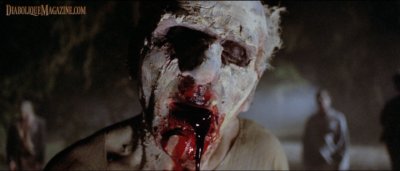
_____
Further
Official Lucio Fulci Website
Lucio Fulci Fansite
Lucio Fulci
@ IMDb
‘The Films of Lucio Fulci’
‘Splintered Visions: Lucio Fulci and His Films’
Lucio Fulci’s films @ Arrow Films
‘LUCIO FULCI, LE POÈTE DU MACABRE’
‘The Italian Godfather Of Gore’
‘Lucio Fulci and the Decaying Definition of Zombie Narratives’
‘LUCIO FULCI – CAT IN THE BRAIN “WEIRD WOBBLER” BOBBLEHEAD!’
‘Five Essential… Films of Lucio Fulci’
Lucio Fulci @ mubi
‘Breaking Down Six of the Horror Master’s Films’
‘Surrealism and Sudden Death in the Films of Lucio Fulci’
‘No Eyes are Safe: Lucio Fulci’
LP: ‘For Lucio Fulci: A Symphony of Fear’
Lucio Fulci Poker Cards
____
Extras
Lucio Fulci at Eurofest 1994 (full)
Do You Remember Lucio Fulci? (Part 2)
Quentin Tarantino on Lucio Fulci
____
Interview
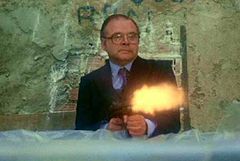
You are no newcomer in the film industry.
Lucio Fulci: I have done films for thirty years and films are all my life. I directed thirty-three movies, but I wrote the scripts for one hundred and thirty. First I studied at the Experimental Film Center in Rome, with teachers like Antonioni and Visconti. Incidentally, when I took the oral exam to be admitted to the Center, Visconti asked me what I thought of his film Ossessione (1943), which was then regarded as a masterpiece, and, with the unconsciousness of my youth, I pointed out that he had “ripped off” quite a few pictures from Renoir’s films! The rest of the jury looked at me as if I was a monster, but Visconti told me: “You are the first person to have told me the truth; you know films and you have a lot of courage – which is what a director needs to have!” And so they took me in!
Then I was assistant director on Marcel L’Herbier’s Last Days of Pompeii, before I launched out into the comedy with Mario Monicelli and Steno (for instance, there was that Christopher Lee film called Uncle was a Vampire). At that time, I was associated with the writing of scripts rather than the directing of films. Since then, except for Zombie 2 Flesheaters, I have been responsible for the scripts of all my films.
Does this mean you prefer writing to directing?
LF: Not really, but my interest in directing is mainly a technical one. To me, the most important parts in the making of a film are script-writing, sound-mixing, and editing. I have a terrible fault: I do not like stars.
Mario Bava did not either.
LF: Nor did Hitchcock, who would send notes to his actors to give them directives. When Paul Newman once asked him why he behaved that way, Hitch answered: “So I don’t have to talk to you!” As a matter of fact, I like working with actors, but not with stars. Bava, since you mentioned his name, had all his films based on technique, special effects, and suspense: so he didn’t really need actors. But Bava was ignored (just like Freda was), and only after his death did critics begin mentioning his genius.
As far as I am concerned, there was one exception – I did work with a star, Toto, the great comedian. I did twenty-two films with him, as a writer or assistant director, and he helped me direct my first film, The Thief, which turned out to be a big flop. At that time, I would do comedies, and rock ‘n’ roll films.
Did you feel any interest in fantastic films yet?
LF: I was a great admirer of Tourneur and Corman – I love Corman’s Poe series. After a while I was fed up with comedies and would not do any more. So I did not work for a year, until, with some friends, I produced a western which I feel belongs in the fantastique, Tepepa. It was very different from the other Italian westerns one could see then: both soft-spoken and extremely violent. The confrontation of two brothers in an unreal climate. Franco Nero, who had not yet been the star of Django, played the first part.
I did my first giallo, Perversion Story, in 1968. Again, it had something unreal in the way a magic San Francisco was shown. But my first true fantastic film was Una Lucertola con la Pelle di Donna, even though it ends like a detective story.
Why this ending, which betrays the very nature of the film?
LF: We were confronted with two possibilities. The story was about a woman, Carole, dreaming of a murder, and finding, when she awakes, that the murder has really been committed. On that basis, you could have two endings, one fantastic, the other in the line of a detective story. The producer insisted that the end be a logical one. The film was very successful in Italy, anyway.
The film contains a lot of astounding dreams, like the one with bats pouncing at the heroine, or that formidable sequence featuring dogs in a laboratory, with their bellies ripped open…
LF: Carlo Rambaldi was responsible for special effects in the bat scene, which was not easy to shoot. He built mechanical bats sliding on wires and flapping their wings; he also added super-impositions of bat shadows. I remember Bava was much impressed when he saw the sequence, though I am sure he would have done it better than me. As for the dogs, Rambaldi used artificial ones, inside which he placed special bags he could control from behind, giving the impression that the heart and bowels were really moving. Some people believed we had used real dogs, which is totally preposterous, as I love dogs, and we had to face a lawsuit. Fortunately, Rambaldi saved me from a sentence to two years’ imprisonment by retrieving one of his synthetic dogs!
The importance of technique is what strikes the viewer most, in this film, and also in Sette Note in Nero.
LF: I have always liked to go forward, to try new techniques. And that’s what I did with Lo
ng Night of Exorcism, too. This very peculiar film deals with witchcraft today. In a small village in Southern Italy, children are killed and a ‘witch’ is accused of these murders by a priest, and is eventually beaten to death with chains by peasants. But the priest finally turns out to be the culprit. When I saw the film it caused a sensation in Italy, I decided to keep on this line and make a totally fantastic film, Sette Note in Nero.
It was no easy enterprise. I had the script ready for a while, but the producers, Luigi and Aurelio DiLaurentiis, got in my way for a year: one day they wanted to do a comedy, the morning after a detective story, and so on. I refused; anyway, they had had me lose a complete year, and I couldn’t have worked in such conditions.
Then I met producer Fulvio Frizzi – the father of Fabio, my composer – and we hired the marvelous Jennifer O’Neil. Thanks to his determination and tenacity, I could make the film just as it had been written originally, and the result proved I was right, as the film finds favor with the youth – the audience all my films are meant for. It’s a film I like very much, but, to some extent, a difficult film, as it is entirely centered upon a woman in relation with objects undergoing changes in their positions and shapes. The editing was particularly difficult, and we had two continuity girls, given all these sequences where dream mixes up with reality and things past and things to come continually mingle.
By then, I had formed a crew of technicians who did not change afterwards: Dardano Sarchetti, writer; Sergio Salvati, cinematographer; Fabio Frizzi, composer; etc.
How did you shoot the scene where a woman falls off a cliff and has her face torn on stones?
LF: We used a trick similar to the one we had used for the final sequence of Long Night of Exorcism with the priest’s death. We had the actress lying on a kind of rail. Then we shifted her, on her sliding board, up to the camera and the stone. At the moment when she reaches the stone, her face is replaced by a close-up of a plastic head, which, when touching the stone, blows off without any fire. The whole sequence thus combines general shots of a mannequin falling off the cliff, medium shots of the actress on the rail, and close-ups of the plastic doll.
Was this film, Sette Note in Nero, a turning point in your career?
LF: It was, because it was my first real venture into the fantastic, but commercially it was a flop: for the following two years, I had to do music shows for television! Then I was contacted by producer Fabrizio de Angelis who had liked Sette Note in Nero so much he was convinced nobody else but me could do Zombi 2. I really enjoyed doing this film, as I had all the crew of my previous films back with me.
So you did not write Zombi 2?
LF: I did not write the original script, but I changed it a lot. I wanted to make an entirely fantastic film, a free film, contrary to Sette Note in Nero, which was based on a mechanism requiring some cerebration. Zombi 2 is based on sensations, hinges on fear, and, of course, horror. In this connection, I am most satisfied with the achievement of Gianetto de Rossi, previously responsible for make-up effects in Jorge Grau’s Living Dead at the Manchester Morgue; I am particularly pleased with that “eye scene” which impressed many people. Gianetto de Rossi couldn’t participate in the making of City of the Living Dead, and was replaced by Franco Rufini, but he was back on The Beyond.
For a fantastic film, you need not only a strong team, but also people who know everything about technique, as it is particularly difficult to do special effects. My associates and myself get along together very well and work in a totally relaxed atmosphere. When we finished shooting Zombi 2, I said we had just made a horror film classic, without knowing it, and, to some extent, having fun like a circle of friends. I say that in reaction to those who think a film can’t be successful if it is not made under some tension.
“Having fun?” What do you answer to those who blame you for all the horror in your films?
LF: Horror is not a goal in itself to me. I am basically interested in the fantastic. As a matter of fact, there are few horror scenes in City of the Living Dead; tension is the important thing in this film. I have given up on horror for horror’s sake, instead I wanted to make a nightmare film where horror is ubiquitous, even in apparently innocuous forms. Horror only appears in two scenes in a spectacular way, let alone the fact that the drill scene is a warning I wanted to give against a certain type of fascism, the girl’s father killing the young guy in such an abject way just because the young guy is different, a frightened victim who, like the so-called witch in Long Night of Exorcism, does not understand all this hostility towards him. I wanted to show this boy as a dropout whom girls protect because of his kindness, but unfortunately, I was not able to develop the conservatism of some Dunwich inhabitants. City, to me, is a visual rendering of the metaphysical side of bad dreams.
I shot the film in Savannah, Georgia, but I changed the town into a nightmare city, so unreal that the audience can’t put a name to it. I tried to achieve the same thing with New Orleans in The Beyond.
To come back to the question of horror in my films, I’d like to point out that the audience usually applauds once a horror scene is over, not while the horror is on the screen. People are wrong when they accuse my films of gratuitous horror; censorship is wrong about my films being an incentive to violence. Far from participating in this violence, the spectator, on the contrary, is rid of it, freed from horrors he holds within himself, the film being the catalyst for this liberation.
The audience indeed applauds most the scene where zombies are burnt out.
LF: Yes, because the audience is against evil, basically, and I think that the Clint Eastwood films are much more harmful to the youth. My films are only nightmares after which you wake up relieved and relaxed. And fantastic films are liberating, especially for the youth, because of this role of the audience. In City of the Living Dead, I paid much more attention to the story than to the zombies, who are only accessories of this story.
City offers quite a few special effects, like the worm rain, or the inside out vision of the girl’s bowels!
LF: It was not easy: actors would not quite accept all those worms stuck up on their faces – we used thousands of them, over twenty pounds! As for the bowel vomiting sequence, we had to use the tripe of a freshly slashed lamb (for after ten minutes, it dries up and becomes unusable), which the actress actually swallowed, and vomited afterwards. For close-ups where bowels rush out, it was of course a doll containing a pump.
Wasn’t The Black Cat a new experience for you, given its very Anglo-Saxon look?
LF: I made this film as a tribute to Roger Corman, though he only did a sketch out of the original story (in Tales of Terror), while I had to do a feature! What interested me in this story was to comment upon the relationship between a man and a cat. The two characters are identical, even though the cat is to win: for the cat may be cruel, but after all he is only the judge, the conscience of this man. The man hates the cat, but, like in the story, he can’t kill him, as nobody can kill his own sick soul. We often try to kill off our bad conscience, to no avail. I was also fascinated with the theme of imprisonment always present in Poe’s works. To me, it’s the most perturbing of all themes: I had Jennifer O’Neil walled up alive in Sette Note in Nero, and Catriona MacColl buried alive in City of the Liv
ing Dead.
What kind of man is Patrick Magee?
LF: He is a marvelous actor, but shooting with him was extremely exhausting, as he has a lot of personal problems. He didn’t actually collaborate much, I even had incredible difficulties with him, but his acting talent is beyond criticism. I think Patrick Magee was the perfect choice for a film I wanted to do as an atmosphere film, not as a horror film. Mimsy Farmer, on the contrary, is terrific: she is both a very friendly person and a very good actress for this type of film. Producers tried to launch her as the “leading American woman in Italy” a few years ago, but, as films like The Black Cat are very rare in Italy, I don’t think she has played in any film since then.
Did you conceive The Beyond as a sequel to City of the Living Dead?
LF: No, my idea was to make an absolute film, with all the horrors of our world. It’s a plotless film: a house, people, and dead men coming from The Beyond. There’s no logic to it, just a succession of images. The Sea of Darkness, for instance, is an absolute world, an immobile world where every horizon is similar. I think each man chooses his own inner hell, corresponding to his hidden vices. So I am not afraid of Hell, since Hell is already in us. Curiously enough, I can’t imagine a Paradise exists, though I am a Catholic – but perhaps God has left me? – yet I have often envisaged Hell, since we live in a society where only Hell can be perceived. Finally, I realize that Paradise is indescribable. Imagination is much stronger when it is pressed by the terrors of Hell.
And there is no way to exorcise this Hell of yours?
LF: No way! I often tried to exorcise my personal Hell to no avail, so now I show it in my films. But, mind you, what is to me the most tragic thing in The House Near the Cemetery is not the people who die, but that little girl who opens for her young friend the gates to the world of the Dead, and saves him from normality (i.e., from the monster who killed the boy’s parents), but also plunges him into the Beyond. In fact, those children do not actually die: they just live in another world in which adults have no power. Finally, the most frightening thing is that the house stays there and will receive other visitors.
Being a Catholic, don’t you believe in Good and Evil?
LF: This may seem strange, but I am happier than somebody like Bunuel who says he is looking for God. I have found Him in the others’ misery, and my torment is greater than Bunuel’s. For I have realized that God is a God of suffering. I envy atheists; they don’t have all these difficulties.
It is true that all my films are terribly pessimistic. The main characters in The Beyond, for instance, become blind, as their sight has no raison d’être anymore in this lifeless world. But humor and tragedy always join, anyway. If they emphasize the tragic side of things, it may have a comical effect. Everything considered, having directed so many comedies when I started my film career turns out to be very useful for my true cinema, the cinema of the Fantastic.
Comparisons have been made between The House Near the Cemetery and Dario Argento’s Inferno.
LF: The themes are different, but I won’t deny there are some connections between Argento and myself. Both films, intentionally, have no structure. We tried in Italy to make films based on pure themes, without a plot, and The Beyond, like Inferno, refuses conventions and traditional structures, while there are some threads in my other films: The House is about a monster, The Ripper is an Hitchcockian thriller, City of the Living Dead deals with Evil, Zombi 2 with death and the macabre. I like The Beyond very much because I think it was an interesting attempt.
People who blame The Beyond for its lack of story have not understood that it’s a film of images, which must be received without any reflection. They say it is very difficult to interpret such a film, but it is very easy to interpret a film with threads: any idiot can understand Molinaro’s La Cage aux Folles, or even Carpenter’s Escape from New York, while The Beyond or Argento’s Inferno are absolute films.
Some people also said that The House Near the Cemetery was a rip-off of The Amityville Horror.
LF: This is not true: in Amityville, you are confronted with something unknown which terrorizes the tenants, while in The House Near the Cemetery, the secret is eventually given away: you know that the monster is a mosaic of corpses. In fact, this film was influenced by Henry James’s The Turn of the Screw and its film version by Jack Clayton, The Innocents. That’s why you can hear at the end of my film this quotation from James: “Are children monsters, or would monsters by children?”, as all that is told may have happened in fact in the child’s imagination – even his parents’ deaths. The spectator may also see the film as a kind of cycle, the events being repetitions of events past.
The fantastic in this film is all centered upon children.
LF: Of course! For instance in that scene where the two children talk together and understand each other though they are hundreds of yards away from each other. Everything is possible in their world; children don’t have the same limitations as grown-ups. That’s the reason why, despite all the audience’s warnings, the little boy goes down into the cellar to fetch the baby-sitter’s head. Children do not have the same hang-ups as adults. Like monsters, they have a different wavelength. So my film borrows from Henry James’s works, and not, despite an accusations I have received, from The Shining. In The Shining, there was a complicity between a child and an adult – the cook of the Overlook Hotel. But in The House Near the Cemetery, adults are totally unimportant. I couldn’t care less about this guy who goes mad in The Shining. I hate The Shining anyway; Kubrick’s coldness was alright for A Clockwork Orange or The Paths to Glory, because it corresponded to the story. But Kubrick’s genius is not made for horror films. The Shining has no feeling.
Isn’t the end of The House – when the little girl helps the boy out of the grave – reminiscent of North by Northwest?
LF: You mean when Cary Grant gets his girlfriend out of the precipice? Yes, it is. I love to make quotations, and there will be many in connection with Huston or Hitchcock in The Ripper.
So what is The Ripper about?
LF: It’s the story of a mad killer committing terrible murders in New York, but to some extent it’s a fantastic film, if only because the police have to spot this madman among twenty million New Yorkers. Much less horror than my previous films, no zombies, but a human killer working in the dark. The setting is deliberately conventional: though I aim at making a new style of thriller, I want to pay a tribute to Hitchcock. The Ripper is in a way a Hitchcock revisited, a fantastic film with a plot, violence, and sexuality.
Did you shoot all the film in New York?
LF: Yes, for four weeks, and with many difficulties, as we had to confront the unions. It’s no easy job sending an Italian crew shooting a small budget film in New York. We had thought of Boston first, because of the famous Strangler, but New York, a town both monstrous and fascinating, finally seemed a better choice. Placing the Ripper in this town would make him a more fantastic figure.
Which of all your films do you prefer?
LF: Beatrice Cenci, which is not a well-known film. I shot it in ’69, and it was painful as I had excruciating personal problems then.
It’s certainly the film I am most deeply attached to, but there is a curse on it. It was released in very few countries, had a poor reception, and all the prints have vanished. (Note: Wrong! There is now at least a French videocassette of this film, entitled Liens d’amour et de sang.)
Is there a subject you have dreamed of shooting?
LF: Yes, I have had a project for years, but I have never been able to get it off the ground. I want to call it Roman Black; it is a study in power. Not a denunciation of power – this has been done so many times… but a thriller à la Chandler, Hammet, or Irish set in Ancient Rome, at the end of the Empire. A new survey of the Fall of the Roman Empire in the form of a thriller. But of course I might have to shoot a totally different film right now. René Clair, once asked what he intended to do after Le Silence est d’or, simply answered: “Another film.” And for us, film directors, that is the question: to be or not to be able to shoot another film.
Is the cinema the thing that counts most for you?
LF: I ruined my life for it. I have no family, no wife, only daughters. All women left me because I never stop thinking of my job. My only two hobbies are my dogs and my sailing boat. Work is very important to me. John Ford once said, “I know that in bars they are saying bad things about me. But I am shooting films in the mountains with Indians while they are talking…”
______________
20 of Lucio Fulci’s 56 films
________________
Lizard in a Woman’s Skin (1971)
‘In 1971, neither Lucio Fulci nor Carlo Rambaldi were Lucio Fulci or Carlo Rambaldi. Sure, Fulci had already directed a staggering 22 films and Rambaldi had done some notable effects work, but neither men had established the reputations that would eventually make them famous. However, as A Lizard in a Woman’s Skin reveals, neither were too far away from that stature at the time; it comes as no surprise that Fulci was just on the cusp of starting a run that would cement him as one of Italy’s best shlock-masters, while Rambaldi was beginning to chart a course that would eventually land him a couple Oscars for stunning effects work on the likes of E.T. and Alien. The recently deceased effects maestro might have received the best “compliment” of his career with his work with The Maestro on this film, as some of his mutilated props were so convincing that Italian courts were convinced the two had engaged in animal cruelty. If not for Rambaldi’s intervention that proved he had just used special effects, Fulci would have served two years in prison, and who knows what might have come of the “Godfather of Gore.” Because of this, A Lizard in a Woman’s Skin probably has a reputation for being a thoroughly graphic shocker; in reality, there’s really only a handful of literal corpses (and some figurative ones).’ — Oh-the-horror
Trailer
Excerpt
_______________
Don’t Torture a Duckling (1972)
‘No mere anti-Catholic polemic, DON’T TORTURE A DUCKLING is an unflinching and an expressly catholic (by definition, “universal, broad in sympathy”) morality play that requires its sinners to pay heavily for their sins: the intense jealousy of Dona Avallone (Irene Papas), which has driven her husband to an early grave, turns back to afflict her own offspring with retardation, while Barbara Bouchet’s sexually teasing Miss Patrizia is humiliated before a phalanx of adult men. Although the brutal chain whipping of Maciara is often read as Fulci’s condemnation of gang mentality, it can also be argued that the vindictive recluse has brought her fate upon herself, heedless as she has been to the calculus of black magic which repays a dark curse (“I’ll break you!”) four-fold. By positing a world in which people suffer the direct consequences of their own words, DON’T TORTURE A DUCKLING transcends glib finger-pointing to speak truth to a culture unbalanced by having one foot planted in an ancient world of saints and martyrs while the other is set in a modern age of lonely people without a vocabulary to express their sadness. The film’s opening image of hands tearing at the earth to deliver up the brittle bones of a stillborn child stands in testimony against a society mooting its own prospects (a sentiment echoed in a snatch of overheard soap opera dialogue that asks “What possible future is there for us?”).’ — Richard Harland Smith
the entire film
_______________
White Fang (1973)
‘Lucio Fulci was a versatile and talented director and I love his work. White Fang is one of his most family-friendly films, and it almost doesn’t feel like a Fulci film because there are no flesh eating zombies or gory murders in it. Fulci is afterall best known for brutal films such as Zombi 2, so it was fun to see him shift gears in this Jack London-based spaghetti western. Those of you who are familiar with London should, however, not confuse this movie with the cute Disney films. It’s a tad more violent, so beware if you have kids.’ — Rare Cult Cinema
the entire films
______________
Four of the Apocalypse (1975)
‘Lucio Fulci, the “Godfather of Gore,” had a knack for turning poorly structured and acted exploitation movies destined to die in the grindhouses into minor works of art. He did this by painting over their mediocrity with blood and guts in a aesthetically stylish manner. Although he is best remembered for directing a handful of cult-classics in the horror genre such as Zombi 2 (1979) and The Beyond (1981), he did make three Spaghetti Westerns: Massacre Time (1966), Four of the Apocalypse (1975), and Silver Saddle (1978). The best of these westerns is Four of the Apocalypse. But while Fulci’s horror genre mentality may have been detrimental to some aspects of the film, that same mentality was likely responsible for the greatest aspect of the film: the unrelenting mood, which is both mournful and mesmerizing, that exists just beneath the surface of Four of the Apocalypse. The awkward one-liners, the overzealous laughing, the odd musical score, the unexpected philosophizing, the obvious emulation of Easy Rider—it all helps establish and maintain this hard-to-describe mood. And it’s this mood of the film, which becomes almost overwhelming in its potency when Fulci repeatedly juxtapositions scenes of extreme violence and tenderness, that makes up for the flaws in the film.’ — Pop Matters
Trailer
_______________
Dracula in the Provinces (1975)
‘Fulci made this film straight after the ferocious violence of Four of the Apocalypse and Avati shortly before contributing his writing skills to Passolini’s Salo. Less surprising are the depths to which Italian comedy would stoop: most offendable groups are catered for. Fulci was no stranger to comedy, this film coming just three years after the better-known The Eroticist and in typical fashion fills the film with rather more than the traditional low-level laughs, with crude nods at Marxism (Nicosia literally sucking the blood of his employees) and an actually quite effective take on the familiar vampire film traits.’ — Horrorpedia
the entire film
_______________
The Psychic (1977)
‘No matter how much you love them, you’d be hard-pressed to defend any of Lucio Fulci’s more famous movies as having really good scripts; his films are barely coherent at best, with generic character motivations and erratic pacing being pretty typical flaws of even his best films. So I was surprised to find that The Psychic (Italian: Sette note in nero, or Seven Notes In Black*) was actually a well-written, involving thriller; the characters were still a bit “stock” but there was a real mystery at its core and even some minor poignancy. Sort of like the crappy John Woo movie Paycheck crossed with a Final Destination movie, Jennifer O’Neill stars as a woman who has a vision of someone’s death, but it’s all very fragmented – she just sees various items (a pack of cigarettes, a magazine, a smashed mirror). After uncovering a body in her husband’s family home, she believes that she had seen the murder as it happened, only to gradually realize that it wasn’t a vision, but a PREMONITION of a death in the same room that she found the other body. So the film is about her putting those pieces together as she tries to find the murderer/prevent the death.’ — Horror Movie a Day
Trailer
the entire film
________
Zombie (1979)
‘My all-time favorite zombie movie is Lucio Fulci’s Zombie. This awesome film has all the key ingredients that are necessary for a classic zombie epic. First, there are zombies and plenty of them. Second, there is plenty of gore, which is very well placed. Fulci was a master of gore, he used, but never abused it in Zombie. The eyeball-puncturing scene is a classic. Third, there are plenty of exploding heads. These zombies are slow moving and easy to kill, but they seem to be everywhere. And, finally man is made to pay for messing with mother nature. Zombie movies always seem to deal in some way with the apocalypse. These are the things that not only make Zombie good, but great on the corpse scale.’ — House of Horrors
Trailer
the entire film
____________
Zombie Flesh Eaters (1980)
‘This audaciously disgusting spectacle from the late master of gruesome horror, Lucio Fulci, was posited as a semi-sequel to George Romero’s Dawn of the Dead, which was released in Italy as Zombi. Tisa Farrow and a group of vacationing tourists travel to an island where they find a doctor (Richard Johnson) who is attempting to cure a condition that reanimates the dead. Things quickly get out of control as undead Spanish conquistadors crawl from their graves hungry for human flesh. The nauseatingly graphic set-pieces by Gianetto de Rossi include a close-up of a woman’s eye being pierced by a large shard of wood and a zombie fighting a Great White shark underwater. This relatively well-made shocker was enormously popular worldwide and led to the zombie-gore film becoming the dominant motif of 1980s Italian horror.’ — Robert Firsching, Rovi
Trailer
the entire film
______________
City of the Living Dead (1980)
‘Per usual, Fulci doesn’t sell his death sequences short. Call it gratuitous, but there’s a admirable grandeur to his gory artfulness. His imaginative eviscerations are masterful and capture the pure physicality of death itself. After all, this is the apocalypse, and he’s an angry god dishing out punishment to a throng of sinners. I’m not sure anyone ever matched a genuine, foreboding atmosphere with outlandish schlock quite as well as Fulci, and that fine mixture is on display throughout City of the Living Dead. Even something like that head-drilling scene seems to go hand-in-hand with the overall madness pervading the picture; this is a film where people lose their heads in supremely violent fashion (literally and figuratively). It’s also worth noting that the Maestro pulls off a truly suspenseful scene early on the film that preys on our fears of being buried alive in a brilliantly strung-out sequence that’s devoid of any gore.’ — Oh-the-horror
Trailer
the entire film
______________
The Black Cat (1981)
‘More of a mood piece than a standard Fulci rollercoast, The Black Cat benefits greatly from a wonderful cast of Eurosleaze veterans, including the always watchable Dagmar Lassander (who looked like hell the next year in House by the Cemetery) and the perpetually abused and unclothed Daniela Doria. The unusual English setting is wonderfully realized by Sergio Salvati’s evocative scope photography, which prowls along the ground, soars over rooftops, and creeps into dark, dusty corners when it’s not too busy flashing back and forth between close ups of actors’ (and cat’s) eyes. Composer Fabio Frizzi takes a break this time, leaving the underrated Pino Donaggio to provide a catchy, lyrical score which remains sadly unreleased to this day. The story bears little resemblance to the Edgar Allan Poe original apart from the title creature and the claustrophobic, ambiguous finale (lifted semi-effectively from Fulci’s earlier Seven Notes in Black, a.k.a. The Psychic), but the gothic mood is well in keeping with the literary master. Watch it back to back with Dario Argento’s The Black Cat from Two Evil Eyes for the full effect (and two contrasting Donaggio scores, to boot). Not all curious fans of European horror will like this film, which moves at a deliberate pace and could be an acquired taste at best, but Fulci fanatics should find enough to savor.’ — Mondo Digital
Trailer
Excerpt
______________
The Beyond (1981)
‘The Beyond, like most Fulci movies, and indeed most Italian horror movies, has a plot that makes sense on paper but not really much once you start paying attention to it. It’s really more just an excuse for creepy imagery and gruesome set pieces, which are by all rights incredibly effective and impressive, if this is the kind of thing you’re into. Of all of Fulci’s movies, and he directed over 50 films in his career, The Beyond is the one that for me has proven the most rewarding on multiple watches, precisely because it’s so oblique and it requires the audience to fill in a lot of the information on their own. It’s not a well-written screenplay, but the artfulness of the direction makes it something special, as does one of the most bombastic and apocalyptic endings of any such film you’re likely to see.’ — Nerdist
Trailer
Excerpt
Excerpt
______________
The House by the Cemetery (1981)
‘Upon first glance, THE HOUSE BY THE CEMETERY is rather restrained for a Fulci film, and possibly the most mature of his “Gates of Hell” trilogy. As with any Fulci film, the plot is all over the place, with plenty never elaborated on or much that’s outright contradictory. Still, this one is comparatively simple and quieter than his other fare, and never quite as flashy in its violence either. Following a family of three as they’re each affected by the haunted house they move into, Fulci fills the story with allusions to mad science, post-mortem communication and creepy townsfolk that interweave into foreboding dread. However, his eye rarely wanders from the family or the house, only divulging into his more hyper-chaotic sadistic bloodletting side when necessary to the story.’ — Fangoria
the entire film
______________
The New York Ripper (1982)
‘If ZOMBIE FLESH EATERS was Lucio Fulci’s DAWN OF THE DEAD, then THE NEW YORK RIPPER is his answer to William Lustig’s 1981 sleaze opus MANIAC. Fulci created something quite unique with ZOMBIE FLESH EATERS, an enjoyable epic of gore- done with undeniable Italian gusto. That film had (brief) shots of New York being over run by the voracious undead. In the NEW YORK RIPPER the Big Apple, or more precisely the female population of the Big Apple, are being terrorised by a razor-wielding lunatic who quacks like a duck. Yep, that’s right- quacks like a duck. Fulci set many of his early 80’s horror movies in America. Or to more precise a no man’s land, much like the USA/UK setting in HELLRAISER (1987), where two cultures collide and produce something unique and unreal. His other two zombie epics; THE CITY OF THE LIVING DEAD (1980) and, what most people consider to be his ‘masterwork’, THE BEYOND (1981), successfully create a surreal Lovecraftian landscape where Italy, the USA and Fulci’s mind melt into each other to create a truly unique culture. Unfortunately, in THE NEW YORK RIPPER, Fulci attempts to emulate Lustig’s movie and the whole New York cop genre to such an extent as to dilute the hallucinatory powers of his earlier films. One thing separates this film from MANIAC and other American sleaze epics of this time is Fulci’s unflinching mixture of sex and eye popping violence. Really, it makes Lustig’s film seem tame in comparison!’ — Hysteria Lives
Trailer
Excerpt
______________
Manhattan Baby (1982)
‘For Manhattan Baby Fulci abandoned the ultra-realistic style and copious gore of The New York Ripper in favor for a return to the surreal oneiricism of The Beyond. Manhattan Baby is among the most restrained of Fulci’s films of this period in terms of gore. The film’s most terrifying scenes are often bloodless, and the image of Marcato convulsing and screaming with Susie’s voice is among the most haunting in Fulci’s oeuvre. Ultimately, Manhattan Baby feels like a complimentary work to The Beyond, one that successfully recreates that film’s style, but is unable to match its power. In a 1982 interview with Starburst magazine, Fulci called The Beyond, “an absolute film… a film of images, which must be received without any reflection.” Manhattan Baby is not “an absolute film” and it is doubtful that Fulci would have considered it to be, but it is incorrect to view it as a failed attempt at such. It is a synthesis of Fulci’s two modes of operation, the sublimely surreal and the mercenary, and comes far closer to achieving a balance to these competing concepts than any of his other films.’ — notcoming.com
Excerpt
the entire film
______________
Murder Rock: Dancing Death (1984)
‘Released in Italian cinemas on 30th April 1984, Murder Rock is perhaps the least well known of Lucio Fulci’s gialli and certainly the most maligned. Sure, anyone going in expecting something like Lizard in a Woman’s Skin, Don’t Torture a Duckling, the infamous New York Ripper (the film of most similar vintage to this) or even the relatively restrained and slightly similar Seven Notes in Black (AKA The Psychic) will probably be left somewhat dissatisfied… but taken on its own merits, this is a stylishly shot, engaging and enjoyable giallo with plenty of points of interest for fans of both the director and, more generally speaking, of this most decadent and deranged of sub-genres.’ — collaged
Trailer
Dance scenes
_____________
Aenigma (1987)
‘In a horror movie, the outcast always gets the last laugh. No, he may not get the girl to live happily ever after with on a beach under the shining rays of the sun, but he most likely will get her with an axe in the woods under the piercing light of the moon. Canadian slashers were built on this foundation and before them was Stephen King’s supernatural first kick at the can, Carrie. You’d think people would stop messing around with the un-cool, but that would take away way too many murder scenarios, wouldn’t it? In 1987, Lucio Fulci crossed into Carrie and just a dash of Suspiria territory with Aenigma, which is hailed as one of his least engaging efforts. As much as Fulci was a phenomenal artist, he never shied away from borrowing from a peer and making it his own. He was never a downright thief, and Aenigma proves just that, even if it is a relatively stereotypical affair.’ — Oh-the-horror
Trailer
the entire film
_____________
Touch of Death (1988)
‘When a film introduces its main character chainsawing a cadaver into pieces, grinding the flesh into hamburger and feeding the slop to a pen of pigs, all with a smile and a calm to rival Martha Stewart, you know this one’s going to be weird! And indeed, TOUCH OF DEATH plays like a John Waters film with extreme gore. Believe it or not, it’s a black comedy with really intense violence. 50s B-movie actor Brett Halsey became a regular Fulci leading man in the latter part of both of their careers and really digs into the role of completely immoral murderer Lester Parsons. He plays his character with tongue firmly in cheek, and hams it up while showing disgust at screwing bearded lady Margie and tolerating Alice, who never stops singing even during sex! The cheesy synth score and Halsey’s great performance keep you chuckling in-between the horror elements; you won’t believe it when a policeman pulls over Lester and writes him a speeding ticket with a corpse in the passenger seat! The gore effects (by Angelo Mattei) are some of the most extreme Fulci would ever photograph. They aren’t as grotesquely beautiful as Fulci’s early gore epics, but one sequence does stand out: the brutal demise of Margie with spurting blood, trademark Fulci eye violence and skin melting! This scene, among a handful of others from this and GHOSTS OF SODOM, would later be recycled in Fulci’s autobiographical film CAT IN THE BRAIN.’ — DVD Drive-In
Trailer
Head in microwave
________________
Cat In The Brain (1990)
‘Italian horror director Lucio Fulci’s mind is his own worst nightmare in this graphically gory fright fest that gained a cult following thanks to an initial ban in the United Kingdom and one of the highest body counts in European cinema. In the midst of completing his latest masterpiece, Fulci is gripped by horrifying specters from his other films. He looks to a therapist to clear his head, but the doctor turns out to be an evil incarnate.’ — collaged
‘Best of’
the entire film
______________
Demonia (1990)
‘Italian horror filmmaker and gore maestro Lucio Fulci (City of the Living Dead, Manhattan Baby) reached the zenith of his career as a cult director with the release of his 1981 classic, The Beyond. This supernatural, gothic-tinged zombie film was essentially the culmination of Fulci’s work as a filmmaker. While he certainly made a few good films after The Beyond (including the infamous New York Ripper) many of the movies were just flat out awful. His 1990 film, Demonia had all the earmarkings of a return to form for the ‘godfather of gore’ a gothic and stylized setting, demonic nuns, and lots of brutal FX work. Unfortunately, the final product would dash the hopes of fans who wanted to see Fulci regain the magic that had been present in the early part of his career. Demonia is a soulless effort which, as Stephen Thrower points out, looks as though it might have been directed by an eager fan of Fulci’s work rather than the man himself.’ — ign.com
the entire film
_____________
Voices from Beyond (1991)
‘Easily the highlight from the twilight era of director Lucio Fulci’s career, Voices from Beyond finds the director aiming for the mixture of gothic horror and queasy gross out thrills that characterized his celebrated streak from 1979’s Zombie into the mid-’80s or so. If the end result doesn’t get close to the level of his zombie masterpieces, it’s at least a respectable shot and makes for a good penultimate film before he finally signed off for good with the much more sedate Door into Silence. Ostensibly a murder mystery but really Voices from Beyond is an excuse to string together a bunch of grisly horror gags (with plenty of very sweaty nudity thrown in for good measure), Voices from Beyond is a brisk, entertaining potboiler from the famously misanthropic director, who was suffering health problems at the time and probably knew his time was drawing nigh. The only real name in the cast is Del Prete (who also died just a few years after this film at the age of 57), an actor best known for his attempt at American stardom in Peter Bogdanovich’s ill-fated At Long Last Love and Daisy Miller.’ — Mondo Digital
Trailer
*
p.s. Hey. ** Ferdinand, Hi, man, good to see you! Oh, you can’t get eBooks? Well, I actually don’t know if her book is in e-format. Oh, wait, send me an email so I’ll have your address, and I can send you a pdf of her book, if you want. Oh, yeah, the Armie Hammer thing. I’m not sure if I can sit through a whole doc — well, hm, maybe actually — but, yeah, fascinating. I’ll go listen to your track this weekend. Great! Everyone, Ferdinand is a super talented fella, and he … I’ll let him tell you … ‘I recently uploaded a pretty lo fi thing for a demo of an electronic song I recorded. All put together on my phone. It’s pretty slow in begining but the distortion towards the end gives me such a thrill to have created with my limited means. Here is a link if you are curious.’ Join me in absorbing it. Thanks a lot for coming in. My eyes are less sore. ** Dominik, Hi!!! Ah ha, on the Elle Nash. ‘Die Closer to Me’ is really, really good. I think you’ll like it. There’s a whole lot of luck involved, yeah. Confidence + luck. I’m just afraid the Sim guy is going to move on to another Eagles album. But not yet. Did love make you less bitchy? And if not, I ask that question very quietly and respectfully, ha ha. Love declaring today International Fake Gory Day with a legal obligation to dress the part, G. ** Misanthrope, I usually go to LA for Halloween every year, except for this year, *waah*, so, yes, I was there doing haunts last year, in that case both for fun and as research for our film which we were getting ready to shoot. No, Paris doesn’t do Halloween. France sucks in that one regard. There’s a Halloween escape room, but I don’t like escape rooms. That, and the Halloween makeovers at Disneyland and Parc Asterix, are it. Oh, I finally saw the roof photos. What a strange and good looking house you have. Your mom looks like a wrinkly faced 70s teen idol. I’m not kidding. ** _Black_Acrylic, Hi. Yeah, shipping shit, here too. And another sale chalked up to former blog star Mr. Kazemi! ** Jason Freeman, Hi. ** Damien Ark, Hey. I saw your email this morning, and I’m going to open it as soon as I’m outta the p.s. Thank you in advance. Finest weekend, sir. ** Jack Skelley, Skellastic! I think I saw that you’re doing a reading with her soon, no? I look forward to hearing about the rad shit this evening, you Zoom cohabiter you. xo. ** DARB🐊, Hi! Oh, that’s cool, busy, I know that one. I just wish my busyness had something to do with Halloween. Well, I guess making Halloween blog posts constitutes a portion of my busyness. Fuck those animatronic dickheads. Give your security guys shoot to kill orders maybe. Sometimes you gotta make money, yeah, I know, and luckily art can have decent preservative qualities when stored in an artist’s brain. No sweat, no rush on the drawing. I am patience incarnate. Have a really, really great weekend by whatever means. ** Audrey, Hi! Learning guitar is really hard. I really tried to get good, but I just couldn’t. My fingers are too klutzy, and my mind races too fast. Oh, right, yes, self-sufficient no budget experimental filmmakers. Very admirable folks. I hope you find someone who’s interested in sharing the visual possibilities. And, yeah, it’ll be a while until Zac and I have a new film idea, but we’re already starting to talk about it, and then let’s talk. That would be awesome. I will share my brain output once I’ve dug into ‘Modern Times’. Soon. Oh, cool, I love ‘Near Dark’. Still my favorite of her films, maybe by a mile. And ‘Gremlins 2’, yep. I might work on the film a bit today or tomorrow. Puce Mary, the great Danish noise music maker who’s doing our score, just made some new tracks, so we’ll listen to them and talk with her. I do a biweekly Zoom book/film club meeting thing with some American writer friends, and that’s tonight. I’m not sure what else I’ll do yet. It’s very gloomy and wonderful outside. Did you get to the park and shoot some images you like? Enjoy everything until next we confer. Love, Dennis. ** Ian, Hi, Ian! Oh, yeah, I loved ‘DCtM’. It is really great. He’s really something with the prose. Yeah, poor, predictable Dodgers. Over here it’s all rugby atm, or I should say it was until France’s team bottomed out the other day. Do report about art and, well, anything else when you like. Very nice to see you! ** Thomas Moronic, Hi, T! I so agree, obviously. How are you? How’s yours going? ** Steve Erickson, I guess you can follow him? Well, I guess you already do. ** 2Moody, Hi. Oh, nice, you know Lauren Berlant. The book’s very good. She died while writing it, and it gets a little faded in the latter part, but still. I do seem to wander into the Japanese district fairly frequently. I do so love Japanese pastries. And, you know, they know how make tea. Satisfying meals are not my metier. I just shove stuff in the microwave then wrap it in a tortilla. I don’t know what exact Halloween candies the store has. They just posted a ‘we have Halloween candy’ ad online, so I’ll find out. I’m pretty easy at the moment. I’m way spoiled here on sweets in France, but I do miss sugar based crap, at least at Halloween. I hope they have edible wax lips. I need a grand weekend festivity. I don’t really spy one out there. Black bean noodles, slurp. They might be gettable. You’re so lucky that you actually have a Halloween to take a break from. I have to be a one-man keep the spirit going machine over here. Report back on your weekend. I can tell it’s a perker-upper already. ** Okay. Let’s get back into Halloween, shall we? And who better to keep the ball rolling than that Italian filmmaking rapscallion Lucio Fulci. That’s my take. See you on Monday.




 Now available in North America
Now available in North America 
Hi!!
Lucio Fulci is a new name to me. Getting to know his work seems like a good way to kick off this weekend. Thank you!
I sincerely hope Mr. Sim won’t get obsessed with another Eagles album – or not anytime soon at the very least.
Haha, yeah, love actually did manage to make me less bitchy, so… I didn’t commit any undue murders.
Okay, yeah, love has my support. Anita’s just bought some fake blood the other day, so we’re all prepared! Love helping the extremely high/drunk guy we ran into this morning find the bus stop he was looking for, Od.
Thanks so much Dennis. Cool post today. In horror film related stuff a friend of mine is hiring a cinema for once a month old cult movie screenings and first up is Carpenter’s Christine and Phantom of the paradise as a double bill. Just got to fill those seats.
Elle Nash: listened to Animals on audible but hoping for the rest to make it there too. It would be really kind of you to send more from her Dennis. Ferdbird77@gmail.com
I’ve long wondered how personal the eye trauma fixation was. It comes up even in MANHATTAN BABY, where no one’s eye gets gouged out.
Have you seen THE DEVIL’S HONEY, Fulci’s erotic thriller?
Although it’s supposed to stop raining here this afternoon, this is our 7th rainy Saturday in a row!
Playboi Carti has been running the Opium label, with only three artists, since 2019. I thought he was just giving a platform to his wanna-bes, but Ken Carson’s fried A GREAT CHAOS actually takes rage a step forward, though it gets a little tired at album length. I’m curious about this subgenre and like Yung Kayo and yeat, but if you look it up and listen to a playlist, you get a flood of WHOLE LOTTA RED soundalikes.
My apartment is being invaded by mice. I caught two yesterday, but they’re still here. I’d be OK with it if you could prevent them from shitting everywhere.
Dennis, Haha, thanks. Yeah, my mom is something else. Doesn’t color her hair either, believe or not. She’ll be 81 in December.
Well, that sucks re: Halloween in France. I’m with you on the escape rooms. They don’t appeal to me at all. I’ve got a friend who’s always trying to get us together to do one. I decline every time. I have one friend who did one, but the escape room people fucked up one of the clues and they got stuck in there for an hour. The people apologized and I guess fixed it for later. Bleh.
Ian McCulloch was the name of the lead actor in Zombie. In 2009 he was introducing the film at the DCA, and I interviewed him in my capacity as a Yuck ‘n Yum editor. He was quite a cool guy who now owns a big Scottish farm, and he had lots of cool Fulci anecdotes from back in the day as well.
Leeds United did really well today because we came back from 2-0 down against Norwich to win 3-2. If a video of the winning goal shows up on Twitter, then I’ll try and post a link to that for you.
HERE is the winner!
I have always liked Fulci’s films for their peculiar mingling of artfulness and sleaze. Indeed, I have always had the sense that he was a workmanlike hack AND a driven visionary with a rather Biercean view of life and the afterlife, and his comments on Hell have always intrigued me. I think that viewing his zombie films through the lens of Gothic archetypes and Fulci’s own somewhat dystheistic worldview offers a little more substance to them.
I’ve only seen The Beyond. Not a fan of the splatter, but there were some visually stunning set pieces. Time to give Fulci another try.
Saw the new Birthday Party doc Mutiny in Heaven. Great fun, lots of period footage and outrageous stories.
Bill
Hi Dennis,
Lucio Fulci!! I’ve only seen a couple of his films but they’re both phenomenal. Zombi 2 is such a strange, dreamy film. And such great gore! I’m running into similar issues with my mind racing while playing guitar, but I’m hoping I can overcome it. I also love Near Dark, but I might prefer Strange Days. That being said, the scene where the main character first sucks blood has stuck with me for a while. It beautifully captures the carnal desire that makes vampirism so compelling. Regrettably I didn’t end up rewatching it in theaters, but I did see Gremlins 2. I love that films Looney Tunes style mayhem (with some wonderful effects work sprinkled in). Good luck on the film, I can’t wait to see it whenever it gets a release! I’ll have to look into Puce Mary, I hadn’t heard of her before. I hope you enjoy the club, what are you reading and/or watching with them? I haven’t made it to the park yet (hoping to get to it tomorrow), but I did shoot a little something for an anthology film a few of those aforementioned experimental filmmaker friends of mine are working on. Enjoy whatever else you’re up to until we next speak!
With Love,
Audrey
We will put the Santa Clarita haunt on our safari agenda. Last night I was Marc Ribot open for The Bad Plus (my of my favorite jazz musicians). Marc was awesome! Wow, you saw Dinosaur L! I’d love to get in a time machine for that one. Arthur Russell is pretty amazing. And Eastman and Russell together – homo music heaven!!! xo
Hi Dennis! I can’t let a Fulci day pass without comment. He’s an all-timer for me. The Beyond is possibly my favorite horror movie…but luckily I don’t live in a world where I have to pick favorites. Amazing soundtrack too, which I’ve been known to play on-set to set the tone from time to time.
How’s everything? I’ve been making festival rounds with the new movie, which has been occasionally fun but also occasionally awful. One festival forgot to download the movie and had to stream it off Vimeo. It paused to buffer like ten times throughout the screening… Terrible! I’ll be in Wales in mid-November to attend Abertoir Horror Fest and will shout hello to you in the general direction of Paris.
Hi Dennis.
How are you? I’m ok. I had a lovely weekend. I stayed with family in Murfreesboro, TN. I got some lovely Mexican ice cream and saw Frankenstein in a theater Friday night, and I went to an arcade and ate quesadillas on Saturday. The arcade was incredible! I played Dragon’s Lair, Galaga, Ninja Turtles, Mortal Kombat and so many pinball games. I had a lovely time. How was your weekend? The only Fulci films I’ve seen are City of the Living Dead and The Beyond, both of which I love dearly. Only natural to continue with The House by the Cemetery. Currently watching more 60s Batman, listening to Oingo Boingo and just enjoying life. Hope you have a good one, Dennis!